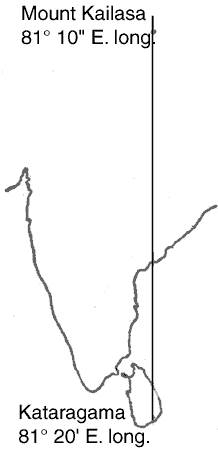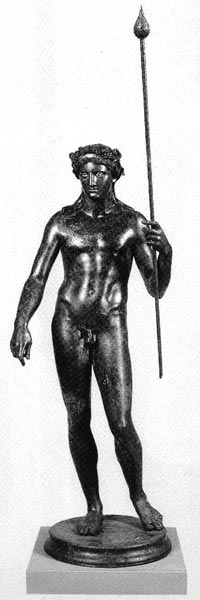|
| |||||||
Sanat Kumāra and the Kataragama Pāda Yatrā(translation from Spanish of "Sanat Kumāra y el Pāda Yatrā a Kataragama" by Dakshinamurti)Kataragama is a sanctuary full of intiatic mysteries for pilgrims of all faiths: Hindus, Buddhists, Jews, Christians and Muslims. The pilgrimage to Kataragama, across the length of Sri Lanka, is done barefoot. It is called Pāda Yātrā and is common to see to Hindu jñanis and siddhars, Buddhist bhikkhus, Sufi bawas and Christian brothers walking barefoot toward the sanctuary of the initiatic mysteries. The local Sri Lankan tradition speaks of a connection between Mount Kailasa and Kataragama. We are told that Sanath Kumara or Murugan descended Mount Kailasa and crossed the Indian sub-continent and came to Sri Lanka to be established in Kataragama. As such, this Kataragama pilgrimage is the oldest pilgrimage that survives since such remote times until today in all its vitality. In remote pre-history there lived in Kataragama the legendary Vedda princess Valli, who attained to cosmic union with the deity of Kataragama, with the eternal (Sanat) youth (Kumara), also known as Muruga, Murukan, Skanda, Karttikeya, Subramanya and as al-Khadir by Sufis. It is said that Gautama Buddha had an encounter with Murugan in Kataragama. According to the Sinhala Buddhist tradition, the historic Buddha Sakyamuni with a large group of arahats transported themselves telepathically to Sri Lanka's Kataragama sanctuary of mysteries. We also bear in mind that Kataragama was a part of the ancient continent Lanka or Lemuria that did not submerge when the mountain range of the Kingdom of Pandya or Kumari Nadu sank under the water of the Indian Ocean and, in that mountain range, was located the sacred Mount Meru that is often mentioned in sacred literature. There in Kataragama was initiated Babaji Nagaraj in the science of Kriya Yoga some 1,800 years ago by the great Siddha Bhoganathar. In the Judeo-Christian esoteric tradition Murugan is known like Melkisedek and in the biblical times the Tamil city of Salem was very acquaintance through the route of the silk as epicentro commercial, cultural and religious, of there he left for the pilgrims of Egypt and caldea the contact with the sacred intiatic Order of Melquisedec. The ancient Greek esoteric tradition knew the island of Sri Lanka by the name of Taprobane and recognised Sanath Kumara as their god Dionysus. In pre-Colombian cultures aimara and quechua knew to Muruga with the name of Aru Mukha. The Sufis, above all the of Sri Lanka, affirm that Murugan is none nother than al-Kadhir, the "Green Man" who appears as the teacher of Moses in the Holy Qur'an (Sura 18, verses 57-83). For many Sufis Kataragama is Serendip, the Paradise wherein is found the Fountain of Eternal Youth. Being Kadhirgama, Katirgama or Kataragama the Sanctuary of the eternal initiatic Mysteries, Kataragama is full of grace or arul (in Tamil), where the Nectar of Immortality, the "amritam" Sanskrit or "ma´ul hayat" Sufi, can be found and drunk. Patrick Harrigan, in his book about Kataragama, speaks of the Lesser or intellectual Mysteries aiming us toward the Greater Mysteries. These last are the goal of all authentic pilgrimage, the transformation of the external trip into Internal Pilgrimage. The oral and written traditions constitute the Smaller Mysteries, while direct living experience is required to penetrate in the Greater Mysteries. IKataragama is described as a spiritual university consisting of diverse classrooms, spheres or states of consciousness, which recalls the work of my soul friend Vicente Beltrán Anglada about Shambhala. Among the siddhars, the most famous of the Pāda Yātrā in modern times were Yogaswami of Nallur (Jaffna) and, among the Holy Sufis, Syed Yabbar Ali Shah or Palkudi Bawa. The Jewish Cabbalists feel attracted toward this Sanctuary by the Mystery of the Satkona Yantra, materialized long ago by the great Siddha Bhogar Nathar, as symbol of Sanat Kumara (the yantra is the Star of David or Six-pointed Star with the Om Tamil in the center, surrounded by a circle of fire). The wisdom contained in this yantra is very deep. There are contents the key initiation and to describe the mysteries it encloses one would need to write a volumous book. Thus the Kataragama Pāda Yātrā is a deeply symbolic initiatic pilgrimage of great antiquity. To penetrate in the Mystery of Kataragama, Katirgama or the Kadhirgama one should penetrate three veils:
Only to remove these three veils the disciple must be prepared to enter the classroom of wisdom, the Sacred Path initiated by Dakshinamurti and brought to our planetary level by the avatars Sananat Kumara and Narada. For every pilgrim who longs for to penetrate into the Living Mystery, whether Hindu, Buddhist, Sufi, Cabalista Jewish or Gnostic Christian, guidelines should be followed while one walks barefoot toward the sacred sanctuary of the Mysteries. The code to follow in the Pāda Yātrā to Kataragama is valid not only for every pilgrim, but applicable in any another pilgrimage. Disciples residing at the Śrī Premananda Ashram are applying this wisdom in their pilgrimages in Tamil Nadu:
The Andean Aramu Muru, the Muruga of the Meru and Kataragama and the Himalayan Sanat Kumar are the same deity worshipped in the three mountain ranges. In the three mountain chains exists the esoteric tradition of the existence of an Internal Kingdom, of Shambhala and its five spheres or classrooms. They initiated them according to their degree in the classroom, sphere of Shambhala or state of consciousness that corresponds to them in the Spiritual University or initiatic path. Aramu Muru, Aru Muruga or Sanat Kumara is considered the King of the World by those arcane traditions, who in the remote past were initiated by Dakshinamurti inaugurating the initiatic Sacred Path on our planetary level. The anthropological investigation of Patrick Harrigan into the mysteries of Kataragama may be summarized, next to other excellent work, in the website www.Kataragama.org dedicated to Kataragama. Patrick, formerly a Buddhist practicioner, arrived to Sri Lanka in 1971 to deepen in his studies of Theravada Buddhism; there he found Kataragama and the Kataragama Pāda Yātrā and was initiated in the study of Sanatana Dharma. At present he collaborates with the Institute of Asian Studies in Chennai and often visits the Śrī Premananda Ashram. After writing this book, based on fieldwork carried out during many years of investigation, he learned of the excellent work of Govindan about Babaji and the 18 siddhas where an extensive perspective of investigation is opened in the ancient and rich Tamil culture. Bibliography and Web sites
Kataragama Devotees Trust home page
|

